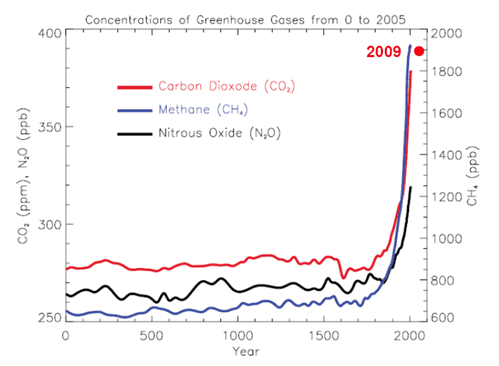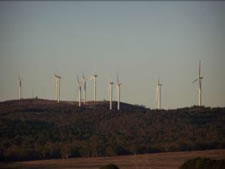Regional Snapshot - Renewable Energy
Renewable Energy – Our Significant Opportunity
Further development of renewable energy in appropriate locations is a major opportunity for the Australian Capital Region (ACR)1. The ACR has a long history of hydro-electricity development, and a new focus on renewable energy is emerging. Electricity generated from renewable energy sources, such as wind, solar, biomass, geothermal and hydro, can help us significantly reduce our greenhouse gas emissions.
Energy consumption in New South Wales (NSW) and the Australian Capital Territory (ACT) increased from 1529 PetaJules in 2006/07 to 1547 in 2007/08.2 Additionally, over half our energy is produced from Black Coal3, producing around 60 million tonnes of greenhouse gas emissions per annum4. This represents approximately 36.6 percent of all greenhouse gas emissions in NSW.5 The burning of this coal has led to increased levels of greenhouse gases, such as carbon dioxide, methane and nitrous oxide in the atmosphere (refer Figure 1).
 |
Source: Inter- Governmental Panel on Climate Change Annual Report 4, 2007
Development of cleaner sources of renewable energy in the ACR provides a pathway for a low carbon future. NSW and ACT Governments have set ambitious greenhouse gas targets. For example, the NSW Government has committed to reduce its greenhouse gas emissions to 2000 levels by 2025, and by 60 per cent by 2050.6 The ACT Government has recently committed to being carbon neutral by 2060.7
In recent years, energy generated from non-hydro renewable sources has increased as a result of the Commonwealth Government’s Mandatory Renewable Energy Target (MRET). In 2009, an expanded Renewable Energy Target (RET) was introduced to bring together the MRET and state and territory renewable energy targets into a single national RET scheme. The new RET requires an additional 45,000 gigawatt hours (GWh) of renewable energy further to the approximately 15,000 GWh of existing renewable energy capacity to fulfill our goal to meet 20% of our energy needs using renewable sources.8
Demand for GreenPower will also encourage further development of renewable energy sources. The NSW Government has made it mandatory for all energy retailers to offer at least 10% GreenPower to new residential customers. GreenPower figures indicate that sales are highest in New South Wales with more than 226,400 or about 8.1% of the State's household electricity customers and 10,300 businesses now purchasing GreenPower.9 These figures represent a 51% and 142% increase respectively, over the same period in the previous year. However, 2009 Australian Bureau of Statistics figures10 indicate that, although ACT has the highest level of awareness of GreenPower, only 5% of ACT customers actually use a ‘Green Choice’ option.

Capital Wind Farm turbines
Photo: Palerang Shire Council
The ACR has significant potential for, solar, hydro and other renewable energy sources. For example, we have significant potential for wind power, with high wind speeds in much of the region. Windfarms, once established, typically produce zero carbon dioxide emissions, and, on average, take only seven months of operation to offset the energy used in manufacture, transportation and construction.11 The ACR also has good year-round solar exposure, making it ideal for capturing and using solar energy.12 Producing renewable energy in the Region offers many distinct advantages. For example, as well as taking advantage of the available resources, we can also produce energy close to our major regional centres, and nearby major cities of Sydney and Canberra, thereby lowering transmission losses.
Windfarms are likely to form a significant part of the region’s future energy developments13, especially those planned and established in the Upper Lachlan and Palerang Shires. The Upper Lachlan currently has 235 wind turbines, and some 250 turbines in total are proposed.14
Interest in renewable energy is growing. One example is the not-for-profit group Clean Energy for Eternity. Beginning in Bega, the group’s work has now been embraced by five councils in the ACR being Bega, Eurobodalla, Bombala, Cooma-Monaro and Snowy River, with (it is understood) Palerang and Queanbeyan likely to join them in 2010. These Councils will strive for a 50% energy reduction and 50% renewable energy by the year 2020 in order to tackle climate change. The target is ambitious and has already created change and support in the local council and communities. For example, in Bega by 2008, 10% of the population was using stand alone or grid-interactive renewable energy.15
Council Responses
While renewable energy offers significant potential, considerable community concerns surround such developments. An integrated regional renewable energy forum with NSW Government, local councils and industry would support a proactive approach to renewable energy planning and development. Within this approach, we need to ensure that renewable energy companies can work cooperatively with Councils to actively apply corporate social responsibility, and appropriately mitigate any adverse social and environmental impacts of renewable energy development.
Potential actions that could be undertaken, in partnership or individually, by Councils include:
- Using planning guidelines to promote passive solar design, mandate and encourage solar hot water in new buildings, and support the uptake of solar panels on buildings.
- Continuing to encourage community education and uptake of renewable and green energy. In addition, Councils should actively partner and promote energy efficiency solutions for their communities.
- Investigating co-generation or tri-generation for large towns and tourist areas where significant facilities are heated
- Investigating options for large scale wind farms considering wind viability as well as significant landscape, aesthetic and community issues.
- Continuing to investigate and encourage investment in solar farms in the region.
References and Footnotes
1 Clean Energy for Eternity – Bega Chapter, 2009, viewed at http://austcom.org.au/672.html
2 Legislative Council General Purpose Standing Committee No 5, 2009, viewed at http://www.parliament.nsw.gov.au/Prod/parlment/committee.nsf/0/3c2f9875a4866dacca2575e
1000c9f78/$FILE/090626%20Media%20release.pdf
3 Robert Mowle, Upper Lachlan Shire Council, personal communication, 28 October 2009.
4 Bureau of Meteorology, 2009, viewed at http://www.bom.gov.au/climate/data/index.shtml
5 OCSE Regional Sustainability Overview 2008.
6 Diesendorf, M, 2003, “Why Australia Needs Wind Power”.
7 NSW Government, 2006, “NSW Renewable Energy Target”.
8 See http://www.abc.net.au/news/stories/2009/11/17/2744715.htm?site=local.
9 ABS 2009, GreenPower Statistics.
10 ABS (Australian Bureau of Statistics).2009. 4102.0 - Australian Social Trends, Renewable energy use and population growth in the states and territories. 25 March
11 The ACR comprises Bega Valley, Bombala, Boorowa, Cooma-Monaro, Cootamundra, Eurobodalla, Goulburn –Mulwaree, Gundagai, Harden, Palerang, Queanbeyan, Snowy River, Tumbarumba, Tumut, Upper Lachlan, Yass Valley and Young.
12 Energy Update 2009, at:http://www.abare.gov.au/publications_html/energy/energy_09/energyUPDATE09.pdf
13 Energy Update, 2009, viewed at http://www.abare.gov.au/publications_html/energy/energy_09/energyUPDATE09.pdf
14 Mullard, B, “Climate Change Background Paper – Mineral Resources” NSW Department of Primary Industries, viewed at http://www.dpi.nsw.gov.au/__data/assets/pdf_file/0006/191238/Climate-change-and-mining---a-background-paper.pdf
15 Ibid.
